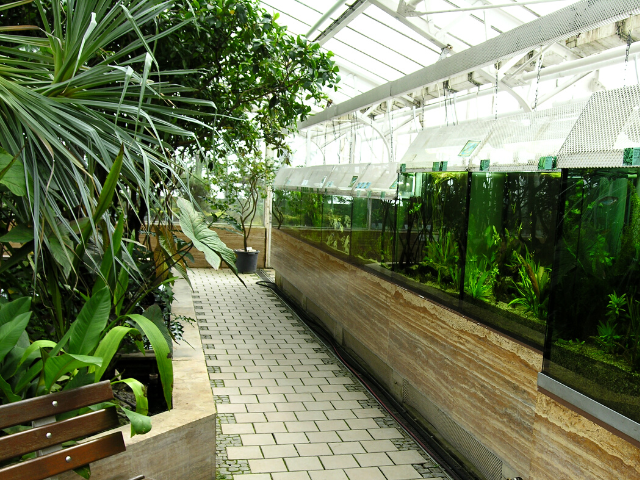Tropical swamp and aquatic plant House
The last side house, branching south from the Palm House, is the Tropical Swamp and Aquatic Plant Show House (House 4). The warm-temperature aquatic plant house is populated along the entire west side with aquariums alive with exotic fish and displaying a palette of unusual underwater plant species. On the south side of the aquatic plant house – separated by a glass pane – carnivorous plants can be seen.
In temperature and humidity, the tropical swamp and aquatic plant house is similar to the summer Victoria house. While the aquatic plants are presented in their underwater form on the right, the left hand side offers the opportunity to get to know aquatic and marsh plants in their above-water form.
The two middle marsh basins are reserved for larger marsh plants, and the southernmost basin, with numerous fish, houses mangrove plants, low trees that grow in the salt water of marshy coastal areas of tropical seas.
The two middle marsh basins are reserved for larger marsh plants, the southernmost basin, with numerous fish, is home to mangrove plants, low trees that grow in the salt water of swampy coastal areas of tropical seas.
Floating plants
In addition to marsh and aquatic plants, numerous plants have evolved into floating plants. In this way, they open up a habitat that is denied to the fixed-rooted plants. A wide variety of floating possibilities are realized here. Some form a spongy, air-filled tissue to gain buoyancy in water. In the case of the water hyacinth Eichhornia crassipes, it is the leaf stalks that serve as floats, as in the case of the occasional floating fern Ceratopteris. In Neptunia oleracea the shoots and in Ludwigia helminthorrhiza the roots are specially modified for this purpose. Other floating plants have strongly water-repellent leaf surfaces, such as the genera Azolla and Salvinia and the water lettuce Pistia stratiotes, caused by dense and velvety hairs.
Special exhibition: Tropical butterflies
Tropical butterflies in all colors, up close: For many people in Munich, the exhibition “Tropical Butterflies” has become a traditional winter experience. Between Christmas and March, the Water Plant House belongs to the tropical butterflies. The butterflies, which come as pupae from butterfly farms, hatch here and can be observed by the public.



